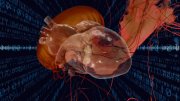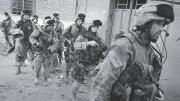During the past few decades, a mounting body of evidence has shown that animals possess a number of cognitive traits once thought to be uniquely human. Bees “talk” through complex dances and sounds; birds act as “social tutors,” teaching song repertoires to their young; monkeys use tools and can sort abstract symbols into categories. Yet the more scientists learn about the similarities between human and animal thought, the greater the need to explain the dramatic divide. Are the human faculties associated with language simply an advanced version of capacities that are found in animals, or do they represent something that is qualitatively new?
This puzzle has drawn the attention of professor of psychology, organismic and evolutionary biology, and biological anthropology Marc Hauser, who has written widely on human and animal cognition. Drawing on a range of recent studies that link the fields of linguistics, biology, and psychology, Hauser has attempted to isolate the aspects of human thought that account for what he terms “humaniqueness.” He maintains that even though human brains have inherited many of the raw abilities observed in nonhuman animal species, a divergence arises from the ways in which multiple capacities interact in humans, allowing them to convert information into myriad forms to serve infinitely diverse ends.
Hauser supports his argument with comparative examples. “Some of the capacities that are critical for language acquisition,” he says, “are in fact present in other species, but used toward more specific nonlinguistic purposes.” Take the concept of singular and plural. Experiments with rhesus monkeys have revealed that they always prefer “many” over “one” of a desired object, suggesting that the singular/plural distinction exists in nonhuman primates and thus likely precedes the evolution of language. But the monkeys don’t distinguish among different gradations of “many”—by opting for three objects over two, or four over three, for example—unless the objects are presented sequentially. Humans, on the other hand, through their novel system of language syntax, have transformed and complicated the way the primitive singular/plural relationship is thought about and represented.
Songbirds offer a further illustration of both the connection and the gap between animal and human faculties. Birds learn songs in much the same way that humans acquire language. There’s a critical early window in which exposure to certain stimuli is necessary; and, as with language, bird songs consist of highly structured sounds that are combined and recombined to create new songs. Yet in the case of birds, different combinations of sounds don’t change the song’s message. Individual variations serve to distinguish one bird from another, like an accent, but the song means only one thing (i.e., “I’m a territorial male…if you’re a female and want to mate, come find me”). “It’s not that birds don’t have thoughts about the world,” Hauser says. “They do. But the combinatorial ability doesn’t get mapped onto the ability to create meaning, the way it does with language—allowing humans to combine and recombine sounds constantly to create different words and expressions.”
Hauser describes animals as having “laser-beam” intelligence, in which each cognitive capacity is locked into a specific function. Humans, by contrast, have “floodlight” intelligence, he says: they can use a single system of thought in multiple ways and can translate information from one context to another. “Animals,” he elaborates, “live in a world in which the systems don’t talk to each other.”
Take tool use, for example. In 1960, when Jane Goodall discovered a chimpanzee using a grass stalk to catch termites, a long-held theory about human uniqueness fell apart. “But the significance of tool use doesn’t lie in the fact of tools,” Hauser explains, “but rather in how they’re conceived and used.” Animal tools consist of only one material and have only one functional part, while human tools have evolved over time to be made of various materials and have multiple functions. A knife can be used to cut food, open a box, or stab an intruder. Forty years of research, he reports, have not revealed any evidence that animals can use one tool for multiple purposes.
Hauser summarizes the distinguishing characteristics of human thought under four broad capacities. These include: the ability to combine and recombine different types of knowledge and information in order to gain new understanding; the ability to apply the solution for one problem to a new and different situation; the ability to create and easily understand symbolic representation of computation and sensory input; and the ability to detach modes of thought from raw sensory and perceptual input.
Across the board, Hauser says, there are signs that animal evolution passed along some capabilities “and then something dramatic happened, a huge leap that enabled humans to break away. Once symbolic representation happened, if the combinatorial capacity was there, things just took off. Precisely how and when this happened, we may never know.”








